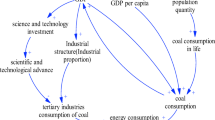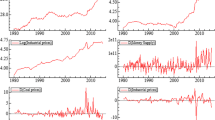Abstract
We analyze and identify the factors that influence coal price fluctuations and construct a system dynamics model of these factors. The simulation results show that the trend in China’s future coal prices first declines and then rises, that the trends of coal supply and consumption in China are quite similar, both exhibiting a rising tendency, and that the gap between supply and demand is small and that the market is essentially in equilibrium. However, the increase in the coal industry profit margins also entails an increase in coal prices, and the magnitude of coal price increases also gradually grows. Greater adjustment coefficient factors lead to higher simulated coal price values, and the magnitude of increase also tends to rise. On the one hand, the greater the coal industry policy coefficient is, the closer the simulated coal price is to the value in the real scenario. On the other hand, the smaller the coal industry policy coefficient is, the greater the extent to which the coal price deviates from the real simulated value.









Similar content being viewed by others
References
Acar S, Yeldan AE (2016) Environmental impacts of coal subsidies in Turkey: a general equilibrium analysis. Energy Policy 90:1–15
Beckmann J, Czudaj R (2013) Is there a homogeneous causality pattern between oil prices and currencies of oil importers and exporters? Energy Econ 40:665–678
Bondia R, Ghosh S, Kanjilal K (2016) International crude oil prices and the stock prices of clean energy and technology companies: evidence from non-linear cointegration tests with unknown structural breaks. Energy 101:558–565
Brahmasrene T, Huang J, Sissoko Y (2014) Crude oil prices and exchange rates: causality, variance decomposition and impulse response. Energy Econ 44:407–412
Chen H, Liao H, Tang B, Wei YM (2016a) Impacts of OPEC’s political risk on the international crude oil prices: an empirical analysis based on the SVAR models. Energy Econ 7:42–49
Chen Y, Yu J, Kelly P (2016b) Does the China factor matter: what drives the surge of world crude oil prices? Soc Sci J 53:122–133
Dennis Lemly A (2015) Damage cost of the dan river coal ash spill. Environ Pollut 197:55–61
Ding ZH, Feng CC, Liu ZH (2015) China’s coal price fluctuations and its influencing factors–based on path analysis. Price: Theory and Practice 9:33–35
Dong J, Cheng Y, Chang T, Zhang JJ, Guo SF (2015) Coal mine methane control cost and full cost: the case of the Luling coal mine, Huaibei coalfield, China. J Nat Gas Sci Eng 26:290–302
Galetovic A, Muñoz CM (2013) Wind, coal, and the cost of environmental externalities. Energy Policy 62:1385–1391
Gogolin F, Kearney F (2016) Does speculation impact what factors determine oil futures prices? Econ Lett 144:119–122
He W, Lu XS (2011) Study on volatility spillover effects between coal price and oil price. J Indust Tech Econ 11:66–70
He Y, Wang B, Wang J, Xiong W, Xia T (2013) Correlation between Chinese and international energy prices based on a HP filter and time difference analysis. Energy Policy 62:898–909
Jammazi R, Lahiani A, Nguyen DK (2015) A wavelet-based nonlinear ARDL model for assessing the exchange rate pass-through to crude oil prices. J Int Financial Mark Inst Money 34:173–187
Joëts M, Mignon V (2012) On the link between forward energy prices: a nonlinear panel cointegration approach. Energy Econ 34:1170–1175
Li AB, Zhou M, Lu MY (2009) Economic analysis and realization mechanism design for full cost of coal mining. Procedia Earth Planet Sci 1:1686–1694
Li X, Ma J, Wang S, Zhang X (2015) How does Google search affect trader positions and crude oil prices? Econ Model 49:162–171
Loutia A, Mellios C, Andriosopoulos K (2016) Do OPEC announcements influence oil prices? Energy Policy 90:262–272
Mou DG, Lin BQ (2012) A study on the interplay between China’s economic growth, power consumption, and coal price based on time-varying parameters. J Fina Res 6:42–53
Ratti RA, Vespignani JL (2013) Why are crude oil prices high when global activity is weak. Econ Lett 121:133–136
Song M, Zhou Y (2015) Analysis of carbon emissions and their influence factors based on data from Anhui of China. Comput Econ 46(3):359–374
Song M, Wang S, Cen L (2015) Comprehensive efficiency evaluation of coal enterprises from production and pollution treatment process. J Clean Prod 104:374–379
Song M, Zhang G, Fang K, Zhang J (2016) Regional operational and environmental performance evaluation in China: non-radial DEA methodology under natural and managerial disposability. Nat Hazards 84(S1):243–265
Tang YW (2008) Research on China’s coal consumption and pricing system. Res Sci 30:554–559
Vujić J, Antić DP, Vukmirović Z (2012) Environmental impact and cost analysis of coal versus nuclear power: the U.S. case. Energy 45:31–42
Wang SJ (2013) Study on spillover effect of energy price volatility in China and abroad. Res Sci 35:690–696
Wang D, Zhang YF, Yin Q, Nie R (2013) Coal price volatility and price discovery function in China. Res Sci 35:1643–1650
Zhang H, Cheng JH (2011) Dynamic effect of China’s energy price fluctuations and resident consumption levels: verification based on the VAR model and SVAR model. Res Sci 33:806–813
Acknowledgments
The authors gratefully acknowledge the respected editors and the anonymous referees for their suggestions in this article. Special thanks are given to financial supports provided by the National Natural Science Foundation of China (71573255).
Author information
Authors and Affiliations
Corresponding authors
Rights and permissions
About this article
Cite this article
Ding, Z., Feng, C., Liu, Z. et al. Coal price fluctuation mechanism in China based on system dynamics model. Nat Hazards 85, 1151–1167 (2017). https://doi.org/10.1007/s11069-016-2626-0
Received:
Accepted:
Published:
Issue Date:
DOI: https://doi.org/10.1007/s11069-016-2626-0




